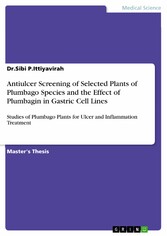Suchen und Finden
Antiulcer Screening of Selected Plants of Plumbago Species and the Effect of Plumbagin in Gastric Cell Lines - Studies of Plumbago Plants for Ulcer and Inflammation Treatment
Mehr zum Inhalt

Antiulcer Screening of Selected Plants of Plumbago Species and the Effect of Plumbagin in Gastric Cell Lines - Studies of Plumbago Plants for Ulcer and Inflammation Treatment
Master's Thesis from the year 2012 in the subject Medicine - Pharmacology, Pharmacy, , course: Masters in Pharmacy, language: English, abstract: ANTIULCER SCREENING OF SELECTED PLANTS OF PLUMBAGO SPECIES & THE EFFECT OF PLUMBAGIN IN GASTRIC CELL LINES Objectives: The objective of the study is to evaluate the antiulcer effect of the Plumbago species and to investigate the most effective plant among the selected Plumbaginales, P.auriculata, P.indica & P.zeylanica after the nvitro evaluation. Materials and Methods: MTT assay was used to perform the cytotoxic effect of the Plumbagin and to scrutinize the least cytotoxic among the Plumbaginales for gastroprotective effect. The DPPH scavenging assay, Lipid peroxidase inhibition assay, Acid neutralising capacity test and Ethanol induced ulcer model were used for assessing the antiulcer effective plant for invivo studies. Ranitidine (20mg/kg, p.o) was used as reference drug in the study. Results and Discussion: MTT results revealed that the Plumbagin showed cytotoxic activity at 40.18?g/ml, P.auriculata is having least cytotoxic effect. Even though significant antiulcer activity were exhibited by all the Plumbaginales and Plumbagin showed significant antioxidant and acid neutralising assays, P.auriculata had decreased the number of ulcers and increased in the percentage gastric protection. Conclusion: P.auriculata showed antiulcer study and the results were compared by Plumbagin, P.indica and P.zeylanica. A future prospect on mechanism based studies and isolation of the constituents is needed for the individual plants.
Alle Preise verstehen sich inklusive der gesetzlichen MwSt.






